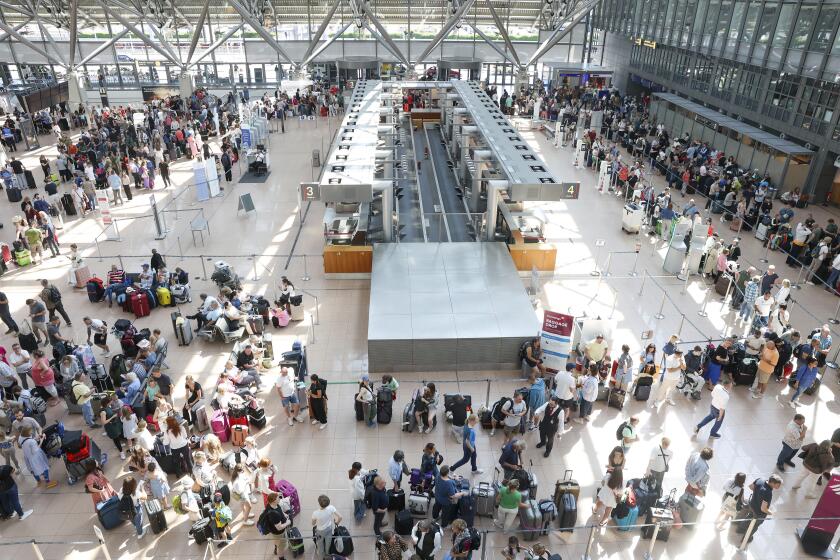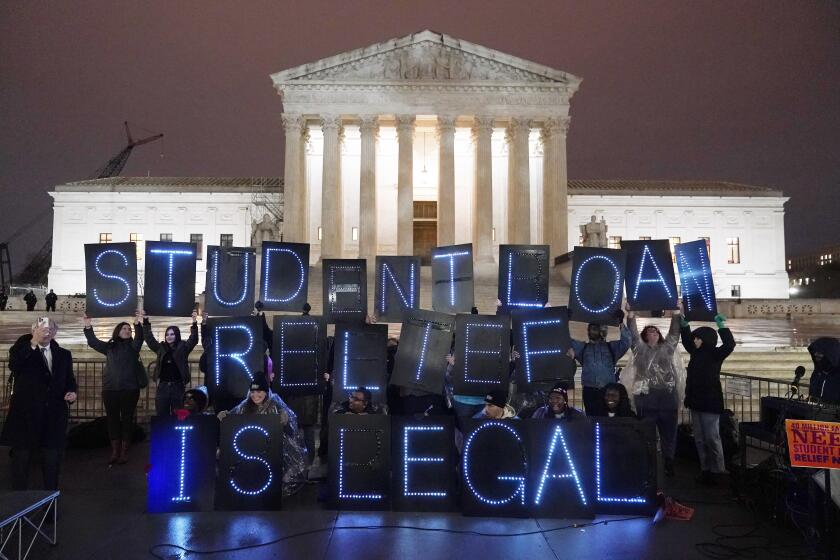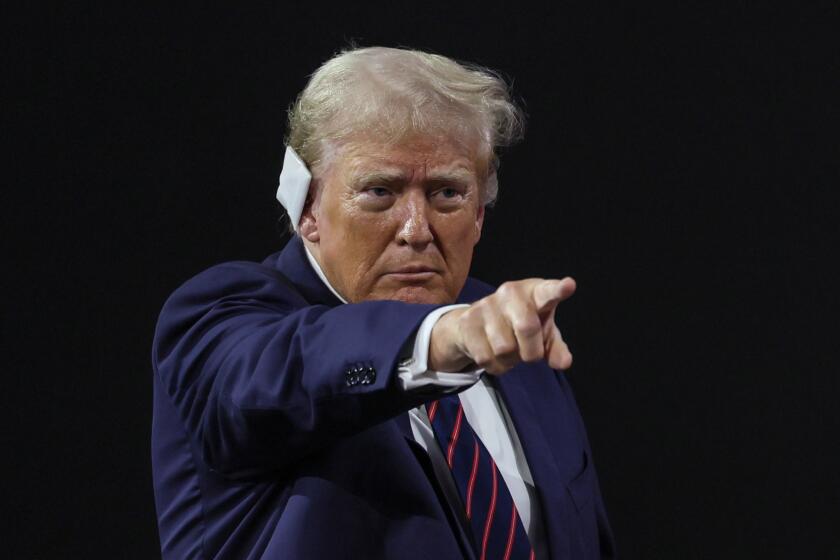India’s Kashmir Torn by Its Attraction to Pakistan
Before a recent cricket match in Lion of Kashmir Stadium here, spectators were searched for Pakistani flags. Anyone wearing green, the national color of Pakistan, was barred from entering.
The authorities were taking no chances. The match was on national television, and no one in the Indian government wanted a repetition of an embarrassing episode that occurred in 1983, when Muslim fundamentalists seized the opportunity to chant anti-India slogans and wave Pakistani flags.
Kashmir, a mile-high region of mountains and valleys, of lakes and floating gardens, of stately chinar trees and apple orchards, of wildflower meadows and glaciers, has an identity problem. It has been likened to a beautiful woman who cannot decide between two persistent suitors, each driven almost mad by her flirting with the other.
Poetry and Prose
The suitors are India and Pakistan. Both nations extol Kashmir’s virtues, in poetry and prose; Jawaharlal Nehru, India’s first prime minister and a member of the Brahman caste from Kashmir, wrote that it was “like the face of a beloved that one sees in a dream.”
India and Pakistan have fought two wars over Kashmir, in 1947-48 and in 1965.
India now controls most of Kashmir, except for a small finger of the Vale of Kashmir, the region’s most famous valley and its population and economic center. Pakistan controls that section of the valley and an uninhabitable mountainous area where the two countries occasionally skirmish on glaciers.
But Pakistan continues to claim all of Kashmir on religious grounds. Pakistan is a Muslim state, and 95% of Kashmir is Muslim.
For its part, India looks on Indian-held Kashmir--included in the state of Jammu and Kashmir--as its best evidence that it is not a Hindu country, although 83% of all Indians are Hindus, but rather a democratic, secular state in which all faiths coexist. Jammu and Kashmir is the only Indian state with a Muslim majority.
Kashmir Happy in Limbo
“Kashmir remains the laboratory of secular and democratic India,” the Indian journalist M.J. Akbar has written. “The idea of India will succeed or fail in this Muslim-majority state.”
Both India and Pakistan have their strident supporters here, yet neither country seems to have won Kashmir’s heart. Kashmir is a place that seems satisfied to remain in limbo. Its strongest commitment is no commitment at all.
Kashmiri leaders have become adept at exploiting Indian fears of losing Kashmir while stoking Pakistan’s territorial lust.
The Mirwaiz Moulvi Farooq, a powerful religious and political leader in Srinagar, observed in a recent interview: “Kashmir is a sensitive border state with a very much awakened population. Sometimes they blackmail India. Sometimes they blackmail Pakistan. Sometimes they blackmail Islam.”
Farooq Abdullah, leader of the National Conference, a political party, agreed.
“Frankly,” he said in an interview, “we use the Pakistan thing to get a little bit more for Kashmir. We go to New Delhi and tell them the people are talking about Pakistan and they give us what we want.”
Farooq Abdullah is the son of the late Sheik Abdullah, the enormously popular political leader who was known as the “Lion of Kashmir.” Sheik Abdullah perfected the routine of playing Pakistan and India against each other. Jawaharlal Nehru, although a close friend of Sheik Abdullah, ordered him jailed in 1953 for “anti-national” activities. Before he died in 1982, the Lion of Kashmir had spent more than 20 years in prison or under house arrest on such charges. Yet at his funeral, attended by hundreds of thousands of weeping Kashmiris, his body was swathed in an Indian flag.
Mecca for Tourists
Kashmir’s stunning beauty has made it a Mecca for tourists. But because it borders on China, Pakistan and Afghanistan, and at one point is only a few miles from the Soviet Union, it is also a place of strategic importance. Several Indian army divisions and air force squadrons are based here.
With a population of 7 million, Kashmir forms only a small part of the Indian whole, but it plays an important role in the policies of all South Asia. For one thing, it is the ancestral home of the Kashmiri Brahmans, the upper-caste Hindus, or pandits, who have dominated Indian politics since independence from Britain in 1947.
The three Nehru-Gandhi family prime ministers--Jawaharlal Nehru (1947-64), his daughter, Indira Gandhi (1966-77 and 1980-84) and her son, Rajiv Gandhi (1984 to the present) are Kashmiri Brahmans.
Indira Gandhi’s political secretary, P.N. Haksar, and Rajiv Gandhi’s political secretary, Makhan Lal Fotedar, also are Kashmiri Brahmans. So are Arun Nehru, Rajiv Gandhi’s cousin and minister of internal security; India’s ambassador to the Soviet Union, Triloki Nath Kaul; and its ambassador to the United States, Pushkar Nath Kaul, who is not related to his Moscow colleague.
Enormous Influence
Kashmiri Brahmans have enormous influence across India, but only about 85,000 remain in the Kashmir Valley where they originated.
Jammu and Kashmir state reflects the region’s divided heritage. The state’s summer capital, Srinagar, is in Muslim Kashmir. The winter capital is Jammu, where Hindus are the majority. Overall, Jammu and Kashmir is 65% Muslim.
Growing Muslim fundamentalism in the Kashmir Valley and Hindu militancy in the plains of Jammu have made the last of the Kashmiri Brahmans feel threatened and insecure.
“We vehemently oppose this fundamentalism; we oppose Muslim and Hindu fundamentalism,” said H.N. Jattu, president of the All-India Kashmiri Pandit Conference.
Troubled by Unification
Particularly worrisome to the Kashmiri Brahmans is the recent unification of fundamentalist Muslim groups in the state into one organization, the Muslim United Front.
“It is the first time all the Muslim fundamentalists have joined hands, and we are all feeling very insecure,” Jattu said.
There has always been some friction between Hindus and Muslims in Kashmir. In the mid-19th Century, the British sold Kashmir to a Hindu maharajah from Jammu, whose family ruled here until independence in 1947. Kashmiri Muslims, an oppressed majority, fought for independence from both the British empire and their Hindu ruler.
But enmity between the two religious groups, who share many shrines in the valley, seldom became violent until recently.
Growing Friction
In February, a dispute over a religious building in the state of Uttar Pradesh, which the Muslims claimed as a mosque and the Hindus believed to be the birthplace of the god Ram, created trouble here in Kashmir. After the religious building, in the town of Ayodhya, was awarded to the Hindus by a Hindu state court judge, a small group of Hindu fundamentalists in Jammu staged a victory march.
Minority Muslims in Jammu charged that they had been assaulted by the marchers. They attacked Hindus in Anantnag, in the Kashmir Valley, and, according to Jattu, 42 Hindu temples were desecrated. Even Hindu temples in Srinagar were stoned.
The most important development in those incidents was the emergence of a charismatic Muslim fundamentalist leader, Qazi Nissar, the Mirwaiz of South Kashmir.
New Tactics
Nissar, who has since been jailed by the government, adopted tactics that have emboldened the fundamentalists. For one thing, he attacked the Indian government’s population control program, arguing that it was a “deep-rooted conspiracy to destroy the majority Muslim character of the state.” He said Muslims should not practice birth control, and he offered to reward Muslim parents who have more than seven children with a cash prize of 21,000 rupees, or $1,600.
Nissar campaigned for the slaughter of cattle for beef in Kashmir. Out of deference to Hindus in Jammu and Kashmir, the authorities do not permit the slaughter of cows, which Hindus regard as sacred.
Nissar’s last act before his arrest came on Aug. 27. A minor state official, the director of food and supplies, ordered Kashmiris not to slaughter any animals on that day, the birthday of the Hindu god Krishna. Nissar defied the order and slaughtered three sheep himself, then took the meat to local markets, where he demanded that it be sold.
Clashes Followed
In September, after Nissar’s arrest, violence erupted in Srinagar, in Anantnag and in the sensitive border city of Baramula, which is near the line of control between India and Pakistan, a line that has been patrolled by a U.N. military observer group since 1949.
On Sept. 19, a political speech by the Mirwaiz Moulvi Farooq outside the main Srinagar mosque resulted in a confrontation with the police. One man was killed. The next day a 16-year-old boy was killed by the police in a demonstration at Baramula.
The demonstrations and violence were marked by pro-Pakistan slogans. Pakistani flags and pictures of the late Pakistani prime minister, Zulfikar Ali Bhutto, were widely displayed. Again the Kashmir tug-of-war was beginning.
“Whether one likes it or not,” Indian journalist M.L. Kohru wrote in The Statesman newspaper, “the fact has to be recorded that Kashmir’s links with India are under severe strain.”
Pro-Pakistan Elements
A former senior Kashmiri official told a reporter that if a plebiscite were held in Kashmir today, the people would choose to join Pakistan.
However, pro-Pakistan elements in Kashmir have always surfaced at times of political uncertainty. The removal in February of the state’s top elected official, Chief Minister Gulam Mohammed Shah, after he failed to deal effectively with the riots in Anantnag, together with the suspension of the state assembly in March, has left a leadership void in Kashmir.
Prime Minister Gandhi has held a series of talks with Farooq Abdullah that many feel is in preparation for the installation of an Abdullah-led government supported by Gandhi’s ruling party, the Congress-I.
In the meantime, the Muslim youths are in the streets chanting pro-Pakistan slogans.
“Those boys don’t really mean they are pro-Pakistan,” Farooq Abdullah said. “They just know what they have to say to get noticed in New Delhi.”
Start your day right
Sign up for Essential California for news, features and recommendations from the L.A. Times and beyond in your inbox six days a week.
You may occasionally receive promotional content from the Los Angeles Times.



